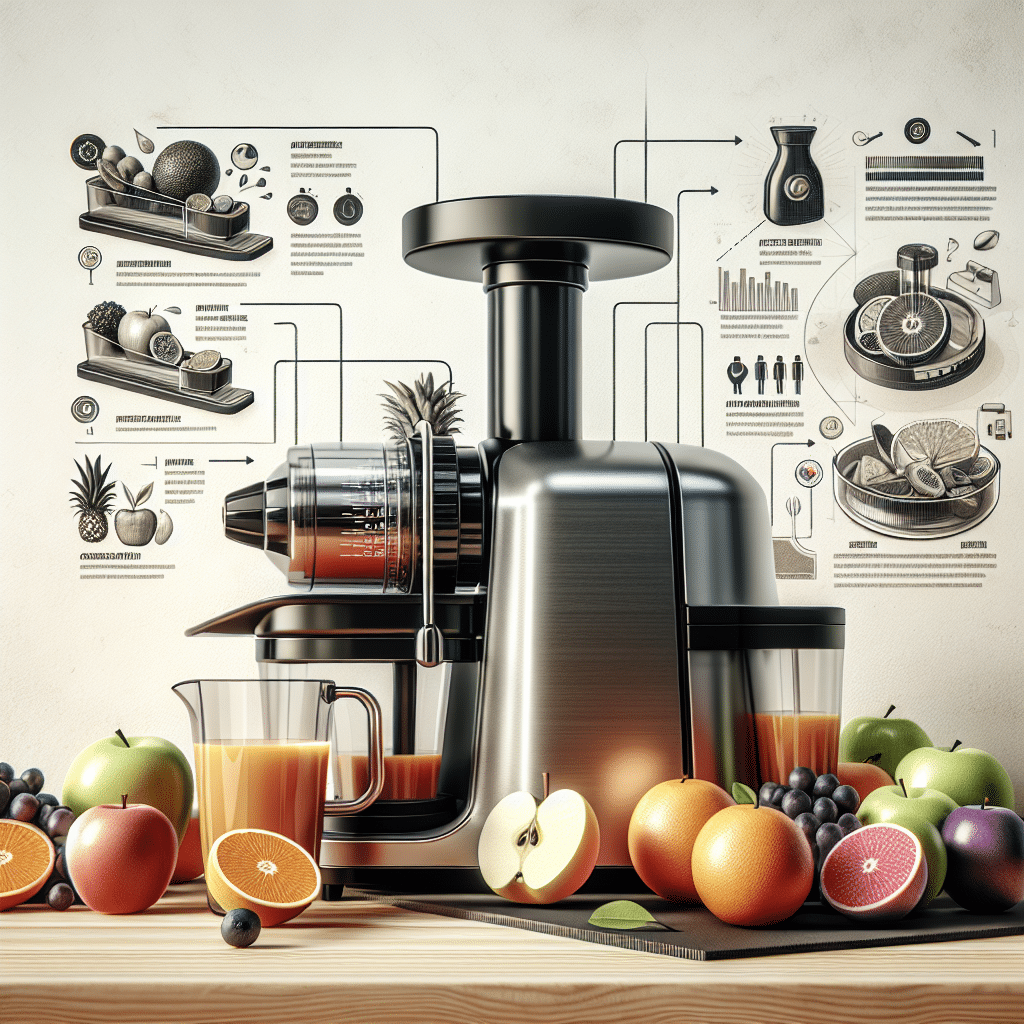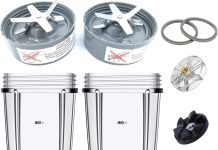If you’re considering getting a masticating juicer but aren’t quite sure about its size and weight, you’ve come to the right place. In this article, we’ll explore the average dimensions and weight of a masticating juicer, giving you a better understanding of what to expect when it comes to this powerful and efficient kitchen appliance. So, let’s dive in and discover the perfect fit for your juicing needs!
Review contents
Dimensions
Height
The height of a masticating juicer refers to the vertical measurement from the base to the top of the juicer. Masticating juicers can vary in height, typically ranging from 12 to 20 inches. The height of a juicer is an important consideration, as it determines how much space it will occupy on your countertop or kitchen shelf.
Width
The width of a masticating juicer refers to the horizontal measurement from one side of the juicer to the other. Similar to height, the width of a juicer can vary depending on the model and brand. Generally, masticating juicers range from 6 to 10 inches in width. It is essential to consider the width of a juicer to ensure it can fit comfortably in your kitchen space.
Depth
The depth of a masticating juicer refers to the measurement from the front of the juicer to the back. The depth can vary among different juicer models, typically ranging from 14 to 18 inches. Consider the depth of a juicer to make sure it can fit properly on your countertop or in any designated storage space.
Weight
Overall Weight
The overall weight of a masticating juicer includes the weight of the main unit, as well as any additional accessories or attachments that come with it. On average, masticating juicers tend to weigh between 10 and 20 pounds. However, it is essential to note that the weight can vary depending on the specific model and features included.
Weight of Main Unit
The weight of the main unit refers to the juicer’s base, motor, and primary components responsible for extracting juice. Generally, the weight of the main unit of a masticating juicer ranges from 8 to 15 pounds. The weight of the main unit is crucial when considering the portability and stability of the juicer.
Weight of Accessories
Many masticating juicers come with additional accessories or attachments, such as different types of screens or nozzles. These accessories can add to the overall weight of the juicer. The weight of the accessories can vary significantly depending on the brand and model. It is important to consider the weight of the accessories, especially if you plan to use them frequently.
Factors Affecting Size and Weight
Motor Power
One of the significant factors that can affect the size and weight of a masticating juicer is the motor power. A more powerful motor may require additional space and components to handle the increased workload, resulting in a larger and heavier juicer. However, it is important to find a balance between motor power and overall size, ensuring that the juicer can adequately perform without being excessively cumbersome.
Feed Chute Size
The size of the feed chute can also impact the overall dimensions of the masticating juicer. A larger feed chute allows for easier insertion of fruits and vegetables, reducing the need for extensive precutting. However, a larger feed chute may lead to a larger juicer size. Conversely, a smaller feed chute may result in a more compact juicer but may require more time and effort for preparation.
Number of Components
The number of components in a masticating juicer can influence its size and weight. Some juicers have a more streamlined design with fewer detachable parts, resulting in a more compact and lighter juicer overall. On the other hand, juicers with more components, such as additional screens or nozzles, may provide increased functionality but can also increase the juicer’s size and weight.
Compact vs. Large Masticating Juicers
Advantages of Compact Juicers
Compact masticating juicers offer several advantages for users with limited kitchen space. Their smaller dimensions make them ideal for smaller kitchens, apartments, or individuals who prefer a more minimalist countertop. Compact juicers are also easier to move and store, making them a popular choice for those who frequently relocate or have limited storage options.
Advantages of Large Juicers
Large masticating juicers, while occupying more space, often boast enhanced features and capabilities. These juicers are typically designed to handle larger quantities of produce, making them a preferred choice for individuals or families who frequently juice or entertain guests. Additionally, larger juicers often have more powerful motors, allowing for efficient extraction of juice from various types of fruits and vegetables.
Comparison with Centrifugal Juicers
Size
When comparing masticating juicers to centrifugal juicers, masticating juicers tend to be larger in size. Centrifugal juicers are often more compact due to their simpler design and lack of intricate components found in masticating juicers. If kitchen space is a primary concern, a centrifugal juicer may be a more suitable choice due to its smaller footprint.
Weight
Centrifugal juicers also tend to be lighter in weight compared to masticating juicers. The simpler construction and fewer components result in a smaller overall weight. This lighter weight can be advantageous for those who prefer a portable or easily maneuverable juicer.
Performance
While masticating juicers may be larger and heavier, they offer superior performance compared to centrifugal juicers. Masticating juicers utilize a slow and gentle squeezing action, which preserves more nutrients, reduces oxidation, and extracts a higher yield of juice. Centrifugal juicers, though more compact and lighter, can generate more heat and oxidize the juice, resulting in a potential loss of nutrients and a lower yield.
Portable Options
Travel-Friendly Masticating Juicers
For individuals who enjoy juicing on the go or during their travels, several masticating juicers are specifically designed to be portable. These juicers often have a more compact and lightweight design, allowing them to be easily packed for trips. Some portable masticating juicers also incorporate features such as a built-in handle or a detachable cord for convenient transportation.
Lightweight Materials
In addition to specific portable juicer models, some masticating juicers utilize lightweight materials to reduce overall weight. Manufacturers may incorporate materials like high-quality plastics or aluminum alloys in their construction, making the juicers more manageable to transport or maneuver while retaining durability and longevity.
Considerations for Size and Weight
Kitchen Space
Before purchasing a masticating juicer, it is crucial to assess your available kitchen space. Consider the dimensions of the juicer to ensure it fits comfortably on your countertop or in your designated storage area. If you have limited space, a more compact juicer may be the best option.
Mobility
If you plan to frequently move or relocate your juicer, consider the weight and portability of the juicer. Lightweight and portable options will make it more convenient to transport the juicer between locations.
Storage
Storage options can also influence the size and weight of a masticating juicer. If you have limited cabinet or shelf space, a more compact and lightweight juicer may be easier to store and retrieve when needed. Additionally, consider the ease of disassembling and reassembling the juicer for efficient storage.
Weight Capacity of Masticating Juicers
Pulp Container Capacity
The weight capacity of a masticating juicer can be determined by the size of its pulp container. The pulp container is responsible for collecting the leftover fibrous material after juicing. Larger pulp containers can accommodate a greater amount of pulp, allowing for longer juice production sessions without frequent emptying.
Juice Container Capacity
In addition to the pulp container capacity, the weight capacity of a masticating juicer can also be influenced by the size of its juice container. A larger juice container can hold more juice, reducing the need for frequent emptying and allowing for larger batches of juice to be produced.
Additional Features
Built-in Pulp Ejection
Some masticating juicers feature a built-in pulp ejection system, which automatically removes pulp during the juicing process. This feature reduces the need for manually emptying the pulp container, making the juicing experience more convenient and efficient. However, it is important to consider the dimensions and weight of juicers with built-in pulp ejection, as they may be larger and heavier compared to juicers without this feature.
Quiet Operation
Many masticating juicers are designed to operate quietly, allowing for a peaceful and undisturbed juicing experience. This feature can be particularly beneficial for those living in shared spaces or those who prefer a silent juicing process. Consider the noise level of a juicer, along with its size and weight, when making your purchasing decision.
Easy-to-Clean Design
A factor often overlooked but essential to consider is the ease of cleaning a masticating juicer. Some juicers have removable parts and dishwasher-safe components, making the cleaning process more convenient. An easy-to-clean design can contribute to the overall user experience, making the size and weight of the juicer less of a hassle during regular maintenance.
Finding an Ideal Size and Weight
Prioritizing Needs
To find the ideal size and weight of a masticating juicer, it is important to prioritize your individual needs. Consider your available kitchen space, mobility requirements, and desired capacity to determine which size and weight range aligns with your preferences and lifestyle.
Consulting User Reviews
Reading user reviews can provide valuable insights into the actual size and weight experiences of masticating juicer owners. Keep in mind that personal preferences and perspectives may vary, so consider a range of reviews and pay attention to any comments specifically related to size and weight.
Product Research
Conducting thorough product research before making a purchase is essential. Explore the specifications, dimensions, and weight details provided by manufacturers. Compare different models and brands, taking into account their specific features and functionalities, to ensure you find a masticating juicer that meets your size and weight requirements.
In conclusion, the size and weight of masticating juicers can vary considerably depending on various factors such as motor power, feed chute size, and the number of components. Compact juicers offer advantages in terms of space-saving and portability, while larger juicers often provide enhanced features and capabilities. When comparing masticating juicers to centrifugal juicers, masticating juicers are generally larger and heavier but offer superior performance. Portable options and lightweight materials are available for those who prioritize mobility. Considerations for size and weight include kitchen space, mobility requirements, and storage options. The weight capacity of masticating juicers is influenced by the size of the pulp and juice containers. Additional features such as built-in pulp ejection, quiet operation, and easy-to-clean design also play a role in finding an ideal size and weight. Prioritizing needs, consulting user reviews, and conducting product research are crucial steps in finding the perfect masticating juicer that meets your size and weight preferences.


































